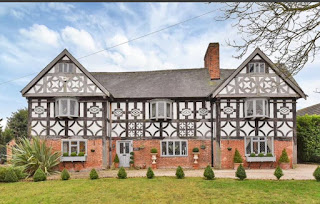Height
I have been trawling through Rightmove, examining properties to write about and becoming increasingly irritated with the poor taste and total lack of imagination on view in English period houses.
Property after property is as bland as possible. They may be lovely, full of light with well designed and maintained gardens, but there is a total lack of understanding of how to make use of the vertical plane.
A period house after the last quarter of the 17th century and certainly by the first quarter of the 18th century, will have fairly high ceilings. The higher status the property the higher the ceilings and doors and windows. And yet neither modern interior designers who ‘do up’ the more expensive properties, nor Joe Bloggs, seems to have a clue about the ‘up’ part of ‘doing up’.
Over and over again, even where period furniture is included in a decorative scheme or ordinary arrangement, it is small pieces, spaced out around the edge of a living room, at the bottom of tall walls, and if there are also fitted carpets in pale colours the effect is ridiculous. Quite often it reminds me of when as a child one knew the dolls house furniture was of a much smaller scale than the large dolls house one was playing with and one felt how silly it looked but could do nothing about it. But these are expensively furnished and often very expensively furnished properties and the owners could do something about it if they had any sense of the vertical plane.
The late, great Roger Scruton spoke of the importance of the vertical in architecture and pointed out how even sky scrapers are often designed entirely in the horizontal plain, with no columns or pillars to break the monotony and to use the space as it was intended to be used in classical architecture. Looking at interiors of houses on the market today is like looking back at old magazines from the mid to late twentieth century, when beds were low divans and modern, cheap furniture designed for utility in small, new post war housing was all the rage, along with flush doors and other horrors even among people living in period properties.
So my advice is buy tall stuff. Regain a proper sense of proportion, literally and you might start to develop one metaphorically. Dress your stately rooms with longcase clocks, secretaire bookcases, chests on chests, cupboards on chests, dressers, livery and house keeper cupboards, bureau bookcases full height library bookcases, cabinet pianos, linen presses, breakfront wardrobes, large mirrors and pictures. And of course dress your tall windows properly ,with full length curtains, with enough width in them to provide vertical pillars of pleats and use pelmets. Stop demeaning yourselves and your properly proportioned homes by making your tiny bits and pieces cower at the edges of your bland fitted carpets and expanses of bare walls looming above them. Make use of the vertical, reinstate your status and leave your inferiority complex behind.
Property after property is as bland as possible. They may be lovely, full of light with well designed and maintained gardens, but there is a total lack of understanding of how to make use of the vertical plane.
A period house after the last quarter of the 17th century and certainly by the first quarter of the 18th century, will have fairly high ceilings. The higher status the property the higher the ceilings and doors and windows. And yet neither modern interior designers who ‘do up’ the more expensive properties, nor Joe Bloggs, seems to have a clue about the ‘up’ part of ‘doing up’.
Over and over again, even where period furniture is included in a decorative scheme or ordinary arrangement, it is small pieces, spaced out around the edge of a living room, at the bottom of tall walls, and if there are also fitted carpets in pale colours the effect is ridiculous. Quite often it reminds me of when as a child one knew the dolls house furniture was of a much smaller scale than the large dolls house one was playing with and one felt how silly it looked but could do nothing about it. But these are expensively furnished and often very expensively furnished properties and the owners could do something about it if they had any sense of the vertical plane.
The late, great Roger Scruton spoke of the importance of the vertical in architecture and pointed out how even sky scrapers are often designed entirely in the horizontal plain, with no columns or pillars to break the monotony and to use the space as it was intended to be used in classical architecture. Looking at interiors of houses on the market today is like looking back at old magazines from the mid to late twentieth century, when beds were low divans and modern, cheap furniture designed for utility in small, new post war housing was all the rage, along with flush doors and other horrors even among people living in period properties.
So my advice is buy tall stuff. Regain a proper sense of proportion, literally and you might start to develop one metaphorically. Dress your stately rooms with longcase clocks, secretaire bookcases, chests on chests, cupboards on chests, dressers, livery and house keeper cupboards, bureau bookcases full height library bookcases, cabinet pianos, linen presses, breakfront wardrobes, large mirrors and pictures. And of course dress your tall windows properly ,with full length curtains, with enough width in them to provide vertical pillars of pleats and use pelmets. Stop demeaning yourselves and your properly proportioned homes by making your tiny bits and pieces cower at the edges of your bland fitted carpets and expanses of bare walls looming above them. Make use of the vertical, reinstate your status and leave your inferiority complex behind.



Comments
Post a Comment